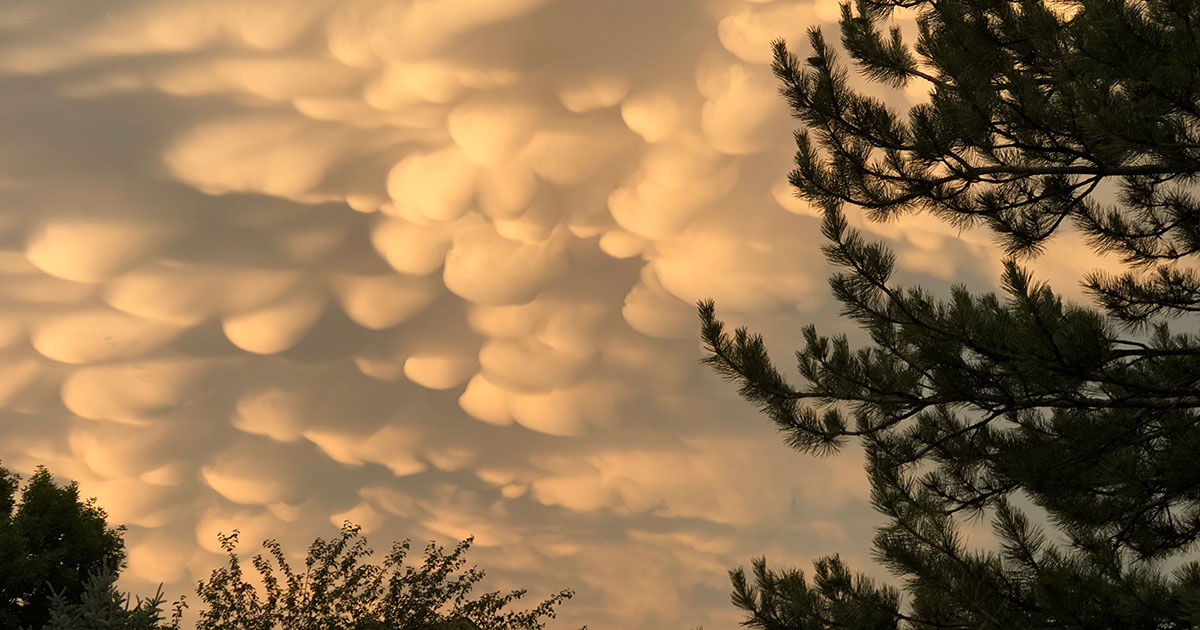
Mammatus clouds, associated with strong convection, grace a sunset over Fort Collins, Colorado, home of the NOAA Cooperative Institute for Research in the Atmosphere at Colorado State University. Photo credit: Steve Miller/CIRA
One of the nation’s most influential atmospheric science-oriented research institutes, based at Colorado State University, has been awarded a new $128 million cooperative agreement with the National Oceanic and Atmospheric Administration.
The Cooperative Institute for Research in the Atmosphere, known as CIRA, supports a broad spectrum of NOAA research, including forecast model improvements, hurricane track and intensity forecasting, real-time satellite tools for the National Weather Service, and forecaster training on use of satellite observations.
First established in 1980 as a partnership between CSU and NOAA, CIRA is among just 16 cooperative institutes established at premier centers of research excellence across the country.
CIRA is a research center of CSU’s Walter Scott, Jr. College of Engineering. The institute is based on the foothills campus at Colorado State, with off-campus teams at NOAA labs in Boulder; Kansas City, Missouri; Washington, D.C.; and Miami, Florida.
CIRA is led by Christian Kummerow, a professor in CSU’s Department of Atmospheric Science.
“We’re very excited to reestablish this fruitful partnership between NOAA and CSU – one that’s lasted nearly four decades and stands on the shoulders of some of the preeminent scientists in our field,” said Steve Miller, CIRA acting director. “This award ensures that our satellite and model development expertise continues to improve NOAA’s regional and global weather forecasts while providing integrated weather information to meet growing needs of the operational weather forecaster.”
Meteorologists around the country rely upon NOAA satellite imagery and forecast models supported by CIRA on a daily basis. CIRA researchers make the connection between forecast models and real-time weather and climate observations, leading to better forecaster awareness and guidance to decision makers and the public.
Other partnerships
CIRA leverages partnerships with other agencies, including NASA, the National Park Service (for air quality research), the Western States Air Resources Council (for air quality planning and analyses), the National Science Foundation, the World Meteorological Organization, and the U.S. Departments of Defense and Energy.
For example, CIRA plays a key role in data processing for NASA Earth science missions such as CloudSat, which probes the internal structure of clouds worldwide, and the forthcoming GeoCARB, which will measure global atmospheric carbon as it relates to climate change.
Among the recent contributions of CIRA to the NOAA enterprise:
- Transforming massive volumes of satellite data into high-resolution imagery and tools for tracking hurricanes, wildfires, dust storms, and other high-impact weather events in real-time – informing decisions such as early evacuations during severe weather, helping to save lives.
- Exploiting the new generation of NOAA’s satellite technology to characterize the nighttime environment in new ways, and at unprecedented quality.
- Helping NOAA to develop, test, and deploy weather forecast models used operationally by the National Weather Service.
- Supporting forecasters dedicated to the nation’s commercial aviation sector – providing safe and efficient routing for domestic and international flights.
The NOAA award is renewable for a second five-year period upon successful mid-term review.
For more information about CIRA, visit: http://www.cira.colostate.edu.